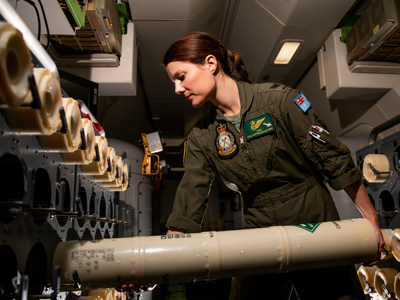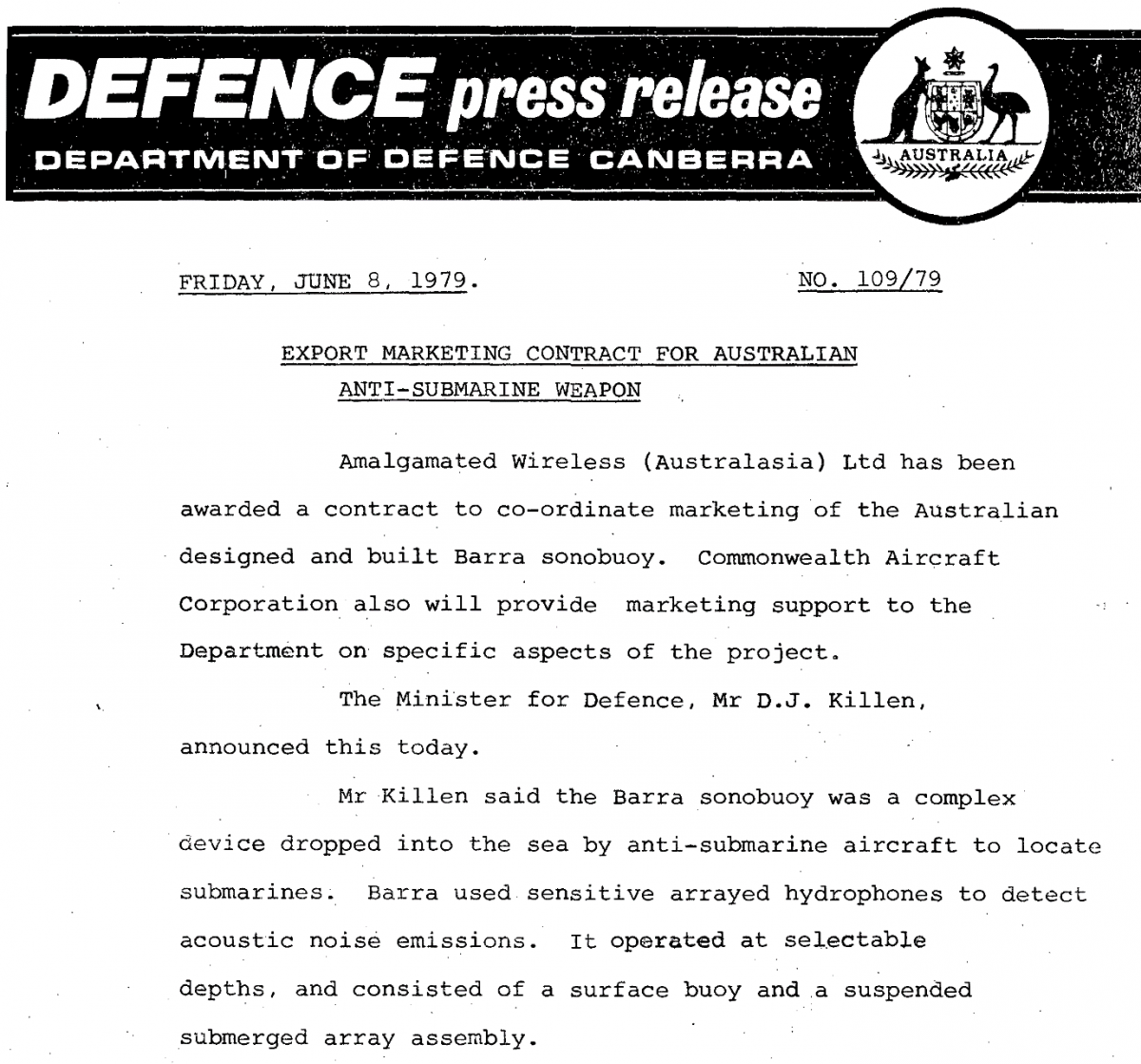The Barra Sonobuoy: the Australian invention that makes it harder for subs to hide

The Barra sonobuoy is one of Australia's most successful Defence joint development projects, and highlights Australia's history as a global leader in the development and manufacture of advanced technologies.
Sonobuoys were first developed and used at the end of World War II in response to the devastating destruction of allied merchant ships in the Atlantic caused by German U-boats.
The ability to locate submarines so they could be sunk, or prevented from attacking, became critical for the Allied war effort, and so the idea of the 'buoy sonar' was born. The idea was simple: a sonobuoy was dropped into the water by passing aircraft and, upon impact, an underwater acoustic sensor (hydrophone) and floating radio transmitter would deploy. Any underwater acoustic signals detected by the hydrophone, caused by a nearby U-boat for example, would then be relayed to the aircraft via the radio transmitter.
However, early sonobuoys that consisted of a single, omnidirectional hydrophone were limited in range and effectiveness. In 1964, Dr Alan Butement, the first Chief Scientist within the Department of Supply, proposed a much more sophisticated concept for a 'directional' sonobuoy, along with Henry d'Assumpcao, later Chief Defence Scientist. Both took out the original patent.

Although Butement and d'Assumpcao conceived of the original idea, its realisation depended on a huge amount work by a vast number of engineers. The Weapons Systems Research Laboratory of the Weapons Research Establishment (which became part of what is now Defence Science and Technology Group) began work on the Barra project, initially known as the Nangana Project, in 1964. Their task was to develop a new sonobuoy system, consisting of multiple hydrophones arranged in a horizontal plane, that could be deployed from aircraft and helicopters to detect, locate and classify quiet submarines and surface ships. This new design provided an improvement on the previous technology through more accurate detection and localisation.

Like its predecessors, the Barra sonobuoy consisted of two parts: a surface float and a sub-surface component that separated on impact with the water after being deployed from an aircraft. The sub-surface component was the Sonobuoy Launch Canister, which was essentially a 1200mm long tube with a diameter of 120mm, which was ejected out of the maritime patrol aircraft using a small explosive source called a CAD (Command Activated Device).
It deployed a small drogue (parachute) to ensure the buoy entered the water correctly. Upon entering the water, a saltwater battery was activated, setting in motion the deployment of both the horizontal acoustic receiver array down to a pre-set depth, and the radio-frequency transmitter that floated on the surface. The acoustic receiver array (originally envisaged as a cruciform array) consisted of 5 telescopic, radial arms that deployed once the buoy was submerged, with 5 hydrophones on each arm that would pick up relevant data and send it via the surface float to a sonics processor in an aircraft.
Two or more sonobuoys working together would allow for the detection of multiple noise sources and their direction of movement.
This gave the Barra a huge advantage over existing sonobuoys -- by having so many hydrophones, the incoming signal was amplified by as much as 14dB, and the processing system could accurately determine the direction of the incoming signal, down to a couple of degrees.
While the concept was straight forward, the engineering task that followed was definitely not. A detector array of several metres in diameter had to be arranged inside a small canister along with sophisticated microelectronics, which could withstand being dropped from a great height, as well as being immersed in water at sometimes close to freezing temperatures.
In the initial development, an underwater test facility was established in South Australia, and the trials undertaken there led to an improved, more efficient sonobuoy model. In 1967, sea trials were completed in St Vincent's Gulf, South Australia and later off Jervis Bay, New South Wales in close collaboration with the Royal Australian Navy and the Royal Australian Air Force.
The development of the Barra sonobuoy system included both the sonobuoy itself, which was designed and manufactured by Australian scientists, as well as a sonics processor – the AQS901 airborne computer, which picked up radio signals transmitted from the sonobuoy and processed them – designed, developed, and manufactured in the United Kingdom in accordance with an agreement made in 1975.
In 1977, Amalgamated Wireless Australasia Limited (AWA Ltd) was awarded the initial contract to produce Barra sonobuoys, and the first production Barra was presented to the United Kingdom's High Commissioner for Australia in 1980, marking the beginning of deliveries of Barra sonobuoys to United Kingdom and Australian Air Forces and Navies.
Over time, more than 56,000 sonobuoys were manufactured, earning Australia over $200 million in exports. The Barra sonobuoy is one of many stories that highlights our long history of innovation in Defence science over the last 115 years.
This article is one of series of articles celebrating 115 years of Defence science and technology. Defence science in Australia can be traced back to 1907 when Cecil Napier Hake was appointed Chemical Adviser to the Department of Defence. Today more than 2000 Defence scientists, engineers, IT specialists and technicians form the Defence Science and Technology Group responsible for providing scientific advice and high-tech solutions for Australia's Defence and national security agencies.

